OCZ Vertex 3 Pro Preview: The First SF-2500 SSD
by Anand Lal Shimpi on February 17, 2011 3:01 AM ESTOverall System Performance using PCMark Vantage
Next up is PCMark Vantage, another system-wide performance suite. For those of you who aren’t familiar with PCMark Vantage, it ends up being the most real-world-like hard drive test I can come up with. It runs things like application launches, file searches, web browsing, contacts searching, video playback, photo editing and other completely mundane but real-world tasks. I’ve described the benchmark in great detail before but if you’d like to read up on what it does in particular, take a look at Futuremark’s whitepaper on the benchmark; it’s not perfect, but it’s good enough to be a member of a comprehensive storage benchmark suite. Any performance impacts here would most likely be reflected in the real world.
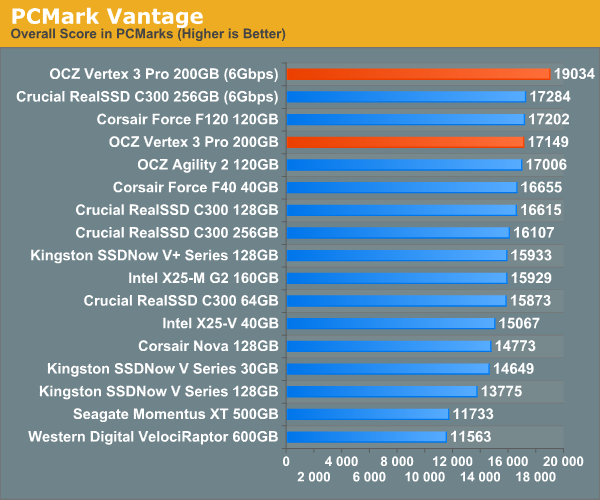
Our PCMark Vantage scores echo what we've seen already - the SF-2500 really needs a 6Gbps controller to shine.
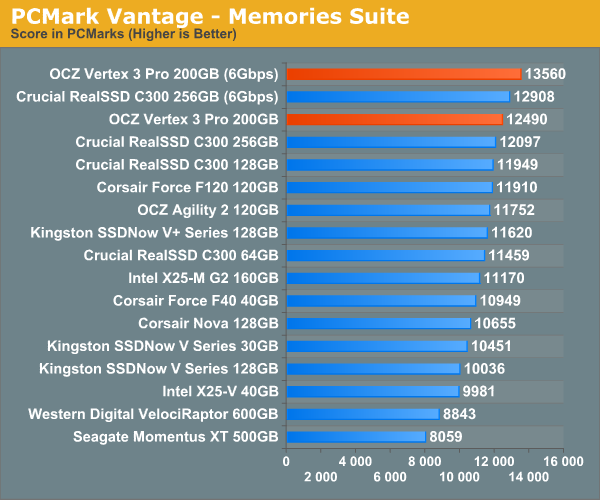
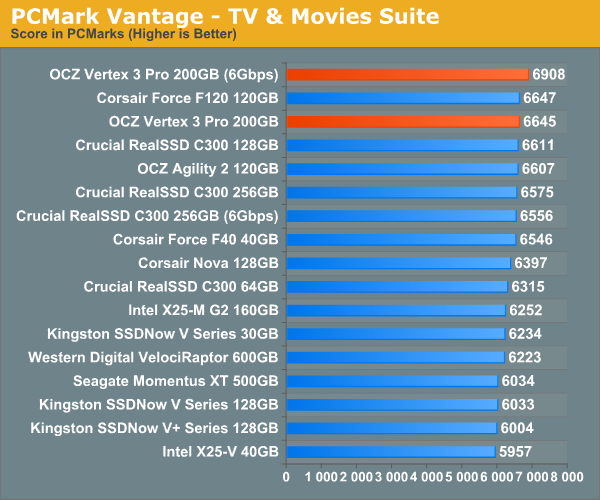
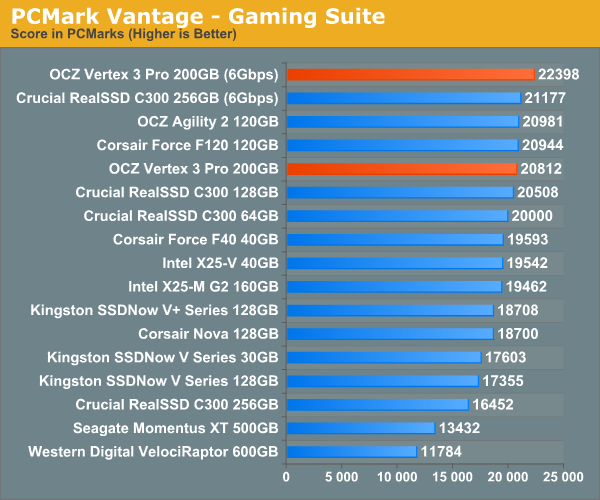
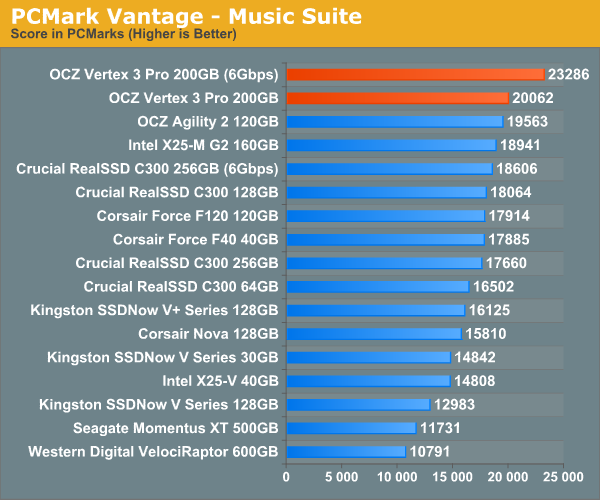
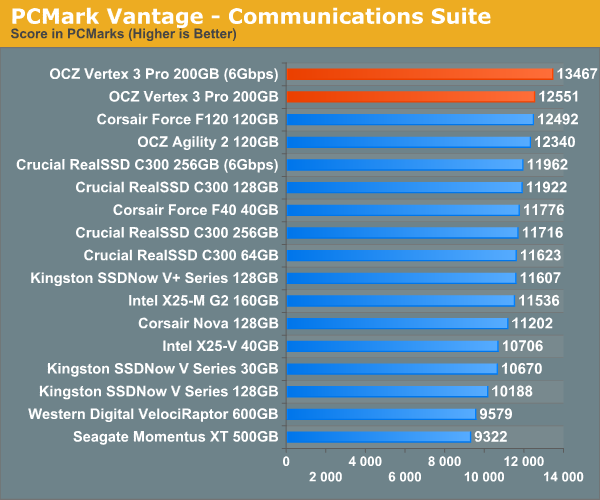
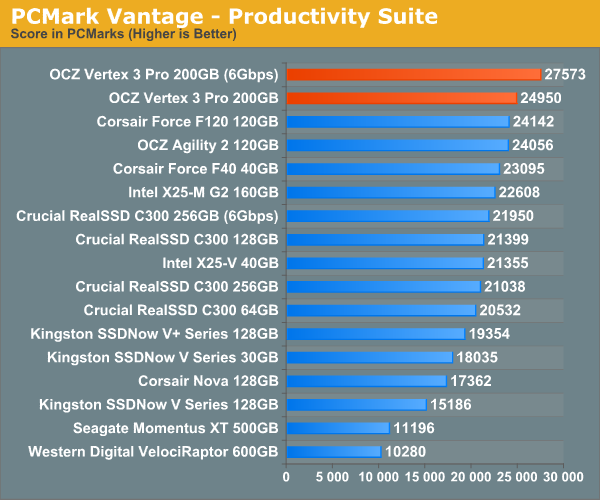
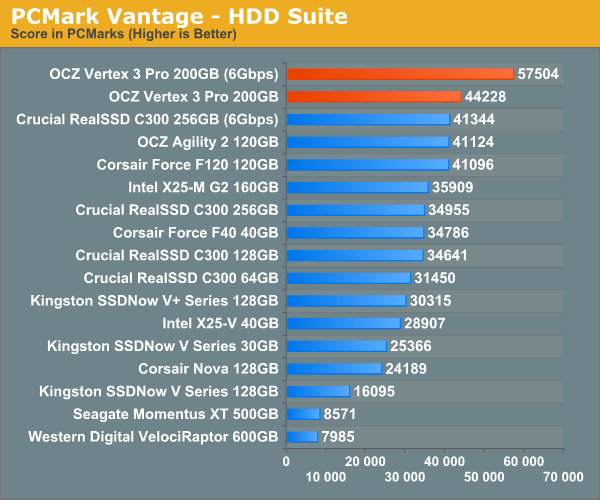










144 Comments
View All Comments
Out of Box Experience - Tuesday, February 22, 2011 - link
Thanks for answering my questionand you are right
with over 50% of all PCs still running XP, it would indeed be stupid for the major SSD companies to overlook this important segment of the market
with their new SSDs ready to launch for Windows 7 machines, they should be releasing plug and play replacements for all the XP machines out there any day now..................NOT!
Are they stupid or what??
no conspiracy here folks
just the facts
Kjella - Thursday, February 24, 2011 - link
Fact: Most computers end their life with the same hardware they started with. Only a small DIY market actually upgrades their hard disk and migrates their OS/data. So what if 50% runs XP? 49% of those won't replace their HDD with an SSD anyway. They might get a new machine with an SSD though, and almost all new machines get Windows 7 now.Cow86 - Thursday, February 17, 2011 - link
Very interesting indeed....good article too. One has to wonder though - looking at what is currently happening with 25 nm NAND in vertex 2 drives, which have lower performance and reliability than their 34 nm brethren ánd are sold at the same price without any indication - how the normal Vertex 3 will fare...Hoping they'll be as good in that regard as the original vertex 2's, and I may well indeed jump on the SSD bandwagon this year :) Been holding off for lower price (and higher performance, if I can get it without a big price hike); I want 160 GB to be able to have all my games and OS on there.lecaf - Thursday, February 17, 2011 - link
Vertex 3 with 25 NAND will also suffer performance loss.It is not the NAND it self having the issue but the numbers of the chips. You get same capacity with half the chips, so the controller has less opportunity to write in parallel.
This is the same reason why with Crucial's C300 the larger (256) drive is faster than the smaller (128).
Speed will drop for smaller drivers but if price goes down this will be counterbalanced by larger capacity faster drives.
The "if" is very questionable of course considering that OCZ replaced NAND on current Vertex2 with no price cut (not even a change in part number; you just discover you get a slower drive after you mount it)
InsaneScientist - Thursday, February 17, 2011 - link
Except that there are already twice as many chips as there are channels (8 channels, 16 NAND chips - see pg 3 of the article), so halving the number of chips simply brings the channel to chip ratio down to 1:1, which is hardly a problem.It's when you have unused channels that things slow down.
lecaf - Thursday, February 17, 2011 - link
1:1 can be a problem... depending who is the bottleneck.If NAND speed saturates the channel bandwidth then I agree there is no issue, but if the channel has available bandwidth, it could use it to feed an extra NAND and speed up things.
But that's theory ... check benchmarks here:
http://www.storagereview.com/ocz_vertex_2_25nm_rev...
Chloiber - Thursday, February 17, 2011 - link
It's possible to use 25nm chips with the same capacity, as OCZ is trying to do right now with the 25nm replacements of the Vertex 2.Nentor - Thursday, February 17, 2011 - link
Why are they making these flash chips smaller if there are the lower performance and reliability problems?What is wrong with 34nm?
I can understand with cpu there are the benefits of less heat and such, but with the flash chips?
Zshazz - Thursday, February 17, 2011 - link
It's cheaper to produce. Less materials used and higher number of product output.semo - Thursday, February 17, 2011 - link
OCZ should spend less time sending out drives with no housing and work on correctly marketing and naming their 25nm Vertex 2 drives.http://forums.anandtech.com/showthread.php?t=21433...
How can OCZ get away with calling a 55GB drive "60GB" and then trying to bamboozle everyone with technicalities and SandForce marketing words and abbreviations is beyond me.
It wasn't too long when they were in hot water with their jmicron Core drives and now they're doing this?